Social media automation. For some people that phrase makes them cringe. For others, it makes them crack a smile knowing a burden has been lifted from some of their everyday duties.
I get it, we all have 24 hours a day to get stuff done.
I have 24 hours in a day.
You have 24 hours in a day.
Your customers and clients have 24 hours in a day.
Here’s the deal:
How we use that time can make or break us and in order to get the most out of those 24 hours, we need to be efficient in how we use our time.
And for most of us, we can use all the help we can get in making to most use of our time.
In the world of social media you have two core options for many tasks.
The first option is manual, back-breaking and time-sucking tasks:
- You can manually post social media updates to each of your accounts across multiple channels.
- Add and remove followers manually from each of your social profiles.
- Manually copy data from your social profiles to monitor activity metrics
And the second option is automated, streamlined and time-efficient tasks:
- Use a platform to automatically post updates to all your social profiles in a few clicks.
- Software that finds and unfollows certain users.
- Social media dashboards that seamlessly pull in core social data and spit it out in nice, easy to read reporting.
There are much better things I can do with my time that can’t be automated.
I don’t know about you, but I am more in favor of using my time wisely and do so through a combination of automated and manual tasks.
But here’s the kicker…
Where do you draw the line of too much social media automation in order to avoid looking like a robot?
What is Social Media Automation?
Before we dive into drawing the line of over automation, let’s quickly define what social media automation is.
I define social media automation as the process in which you reduce the amount of manual time required to complete repetitive tasks for your social media accounts through the use of tools and/or services.
Trust me when I say that there are no shortage or social media tools to help with your automation needs. In fact, there are over 500 different social media tools.
A large amount of these tools help you streamline and minimize the amount of time needed to perform specific actions or tasks in your social media accounts.
Social Media Automation – Too Much of a Good Thing?
When you decide to use social media automation software to assist with your social media initiatives, where do you draw the line?
I’m definitely not an advocate for automating your entire social presence, it kind of defeats the purpose of social media.
However, I am a fan of automating mundane social media tasks. For the most part these are repetitive and scalable processes that would cause me to go insane if I had to do them on a regular basis.
But there is definitely one thing you shouldn’t automate. And to me, that’s interaction.
Don’t Automate Interaction
One form of automation I use (as well as many other social media experts) is the scheduling of various social media updates. These posts are used to seed the conversation.
Typically, once posted (depending on the channel) they will generate some interaction. These could be in the form of a comment, a retweet, or perhaps a like.
Through the use of automation, the conversation has been started.
It’s now up to you to continue it.
Whether it’s as simple as thanking someone for retweeting, or perhaps providing a response to a comment left from a follower.
This is something I don’t think you should automate (even though you probably could).
Stop the Auto Direct Messages
Another line-crossing use of social media automation software is the automatic direct message on Twitter.
Yes, direct messages could potentially fall under the scalable and mind numbing exercises you could look to automate.
If you are like me you probably avoid the cesspool of your Twitter inbox that is no doubt littered with messages that don’t interest you.
I avoid it because of the auto-DM.
It has turned the Twitter inbox into a black hole of shameless self-promotion and essentially ruined any real value your inbox could have provided you.
I don’t know about you, but I don’t have time to sift through hundreds of messages to find a legit message asking a question or needing help.
For the purpose of this blog post, I took quick peek for some proof (not that you probably need it)…I’m pretty sure just about every message in my Twitter inbox is automated. Here’s some proof:
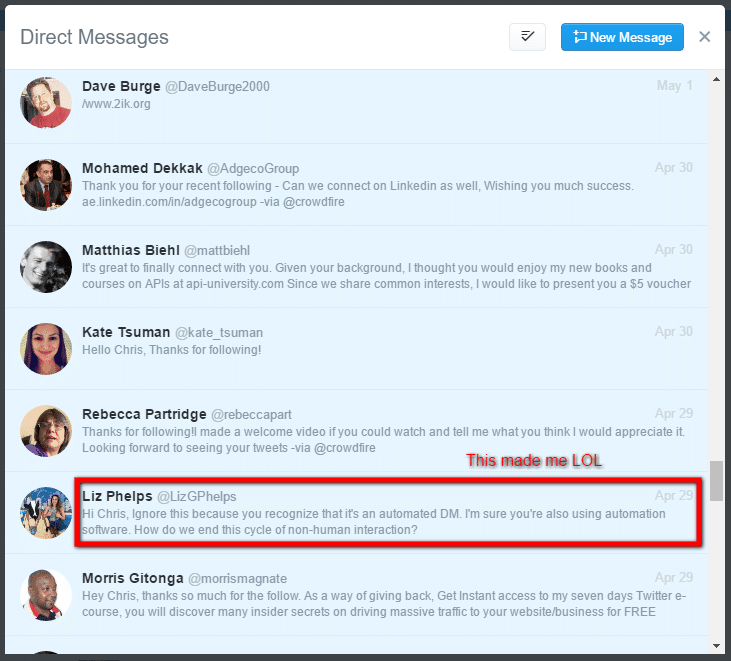
At least Liz wasn’t hiding anything, so it gave me a good laugh. Why yes, I do use some automation.
If you are going to use automation for direct messages, use a better message. Don’t use it to pitch your link, use it to start a conversation.
I understand that a lot of the junk that ends up in my inbox is because of some of the automation I use and I am at peace with it. I just choose not to go into my inbox because of it. I have better things to do with my time.
I honestly haven’t even opened my Twitter inbox in forever, except for the instance above.
I’ve never jumped on the auto direct message train, but would be curious to hear your opinion if you currently use it and what kind of results you have seen.
Quit Auto @ Replying Your New Followers
One more thing that can cross the line of too much social automation is automatically sending “@ replies” to your new followers.
If you are going to automate this, at least set it up right. I mean, come on…my first name is on my Twitter profile!

Look, I’m all about new followers sending me an @ reply that is relevant to me.
For example, if they view my Twitter page and see that I like bacon (and who doesn’t) or notices that I enjoy watching NFL football and ask who my favorite team/player is and use that in the at reply. I know It’s authentic and chances are it is not automated (one day we will probably have tools that can be smart like that).
Here’s the right way to do an @ reply to a new follower. She clearly took a minute to check out my bio. It’s a legit interaction.
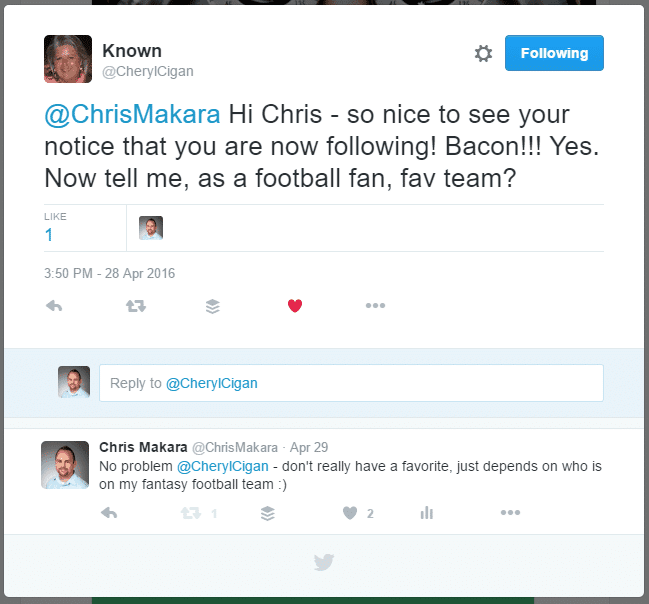
It is too much automation when I can view a user’s profile and see the exact same @ reply sent to all their followers. This approach is a definite red flag for the overuse of social media automation.
For example, you don’t want to do this:
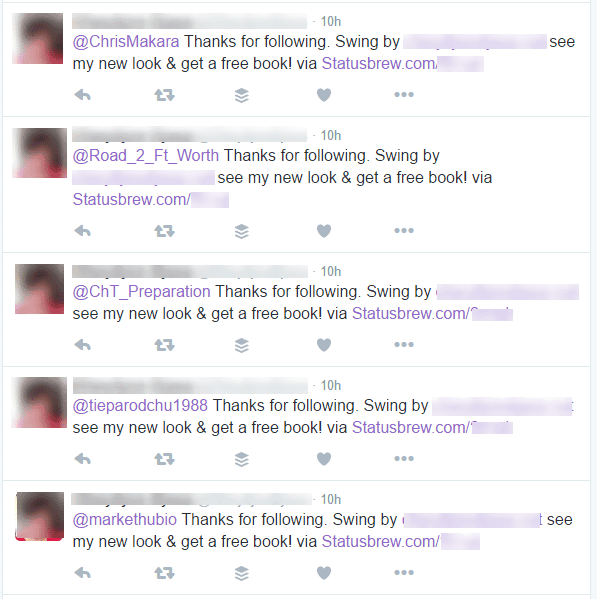
Not sure why I blurred out the guilty party here, but it’s not too hard to find the culprit if you want to.
Finding a Balance for Social Media Automation Software
The trick when using automation for social media is to find the right balance that allows you to be more efficient with how you use your time while also being able to be active and authentic with your audience.
Everyone’s situation will be different.
It’s up to you to test and find out what makes the most sense for what you need to accomplish.
I do think there are core automation tactics that can be used by most – again your social media goals may differ.
Scheduling & Posting Social Media Updates Automatically
At the core of almost any social media automation strategy you will find the scheduling and publishing of social media updates. This approach will work on most major social media platforms.
Scheduling social media content in advance will allow you to fill up your social content calendar ahead of time. This will allow you to have a social presence during the times you schedule these updates.
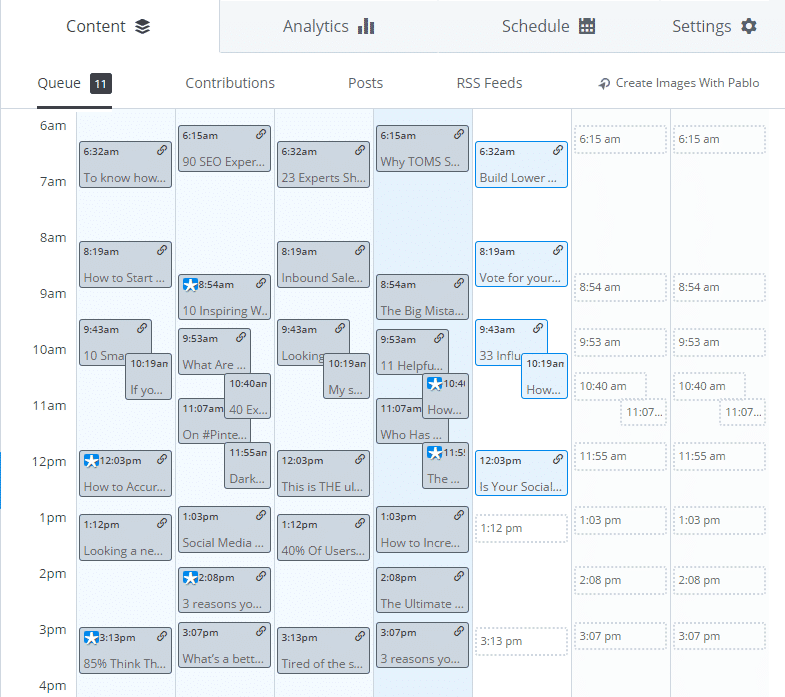
It’s a smarter approach than the alternative of logging into each social site every few hours to post an update.
Most scheduling tools can cross post to multiple social channels and accounts which can save you time.
As long as you don’t schedule updates every two minutes and have them spaced out, this social media automation strategy is accepted by many.
Unfollow Inactive or Users Not Following You Back
Of course depending on the social media channel, this might not be possible.
The basic idea of trimming down the number of people you are following is to make your account appear more influential in that you have more people following you than you are following.
Of course, this does not mean your account is necessarily influential.
Ultimately it will come down to the value you can deliver your audience.
However, to pass visual inspection of being perceived as an influencer if you have more followers than you are following many will view your account with higher regard.
Automate Social Media Reporting
If you are not tracking what you are doing on social media, then how do you know what is or isn’t working?
There are quite a few platforms that can create social media reports for you which makes it easy for you to get insight into your social initiatives. Most of these services can send you daily, weekly, or even monthly reports right to your inbox.
They take a few minutes to set up (if that) and then you just wait for them to magically appear in your inbox.
Or if you want to rely on Google Analytics to show you your social media initiatives, you can set up daily, weekly, or monthly reports to be emailed to you as well through Google Analytics reporting. Depending on your social media goals, this can be a nice free alternative that is easy to implement.
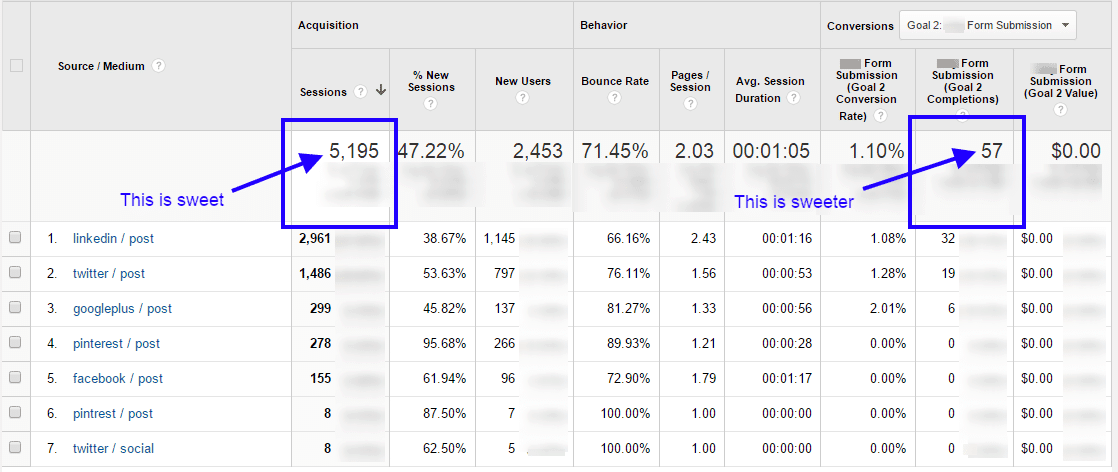
Finding the Right Balance For Social Media Automation Tools
Social media automation tools should be used to help you be more efficient with tasks that don’t really need a human touch. So before you implement any sort of social media automation, you need to take a look at what can and should be automated as well as what shouldn’t.
For example, you might decide it makes sense to automate these tasks:
- Scheduling and publishing social media updates across multiple channels
- Automated weekly social media reports
- Use RSS feeds to generate content for your social accounts
You may decide these tasks must be performed manually by a human:
- Sending a greeting to new followers
- Thanking users for sharing your content
- Curating content for upcoming social media posts
- Engaging with your audience
Double check your list, and if you are seeing too much automation with very few manual tasks around engagement you might want to reconsider where you placed certain tasks. The idea is to come up with an approach that leverages automation and allows you to spend more time on engagement with your audience. So the more engagement tasks in your manual section, the more balanced your social accounts should be.
Once you have decided what you want to automate, you can then look at the different social media tools that can help you get it done.
Again, you’ll probably need to test and tweak as you see what does and does not work.
In the end, you want your account to be human…not a robot. Unless you are a robot?
Your Thoughts Social Media Automation?
How do you find the right balance for a social media automation strategy? Are you all in and automate everything, or do you have a mix of automation and manual approach? Maybe you don’t automate anything.
Leave a comment below and let me know your thoughts on balancing social media automation.


